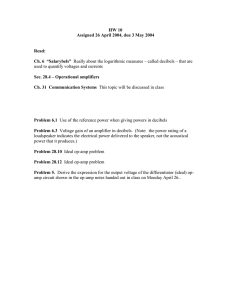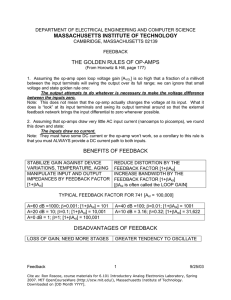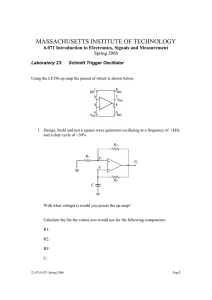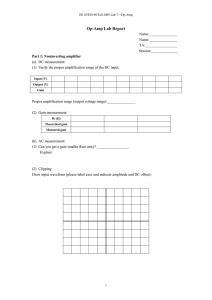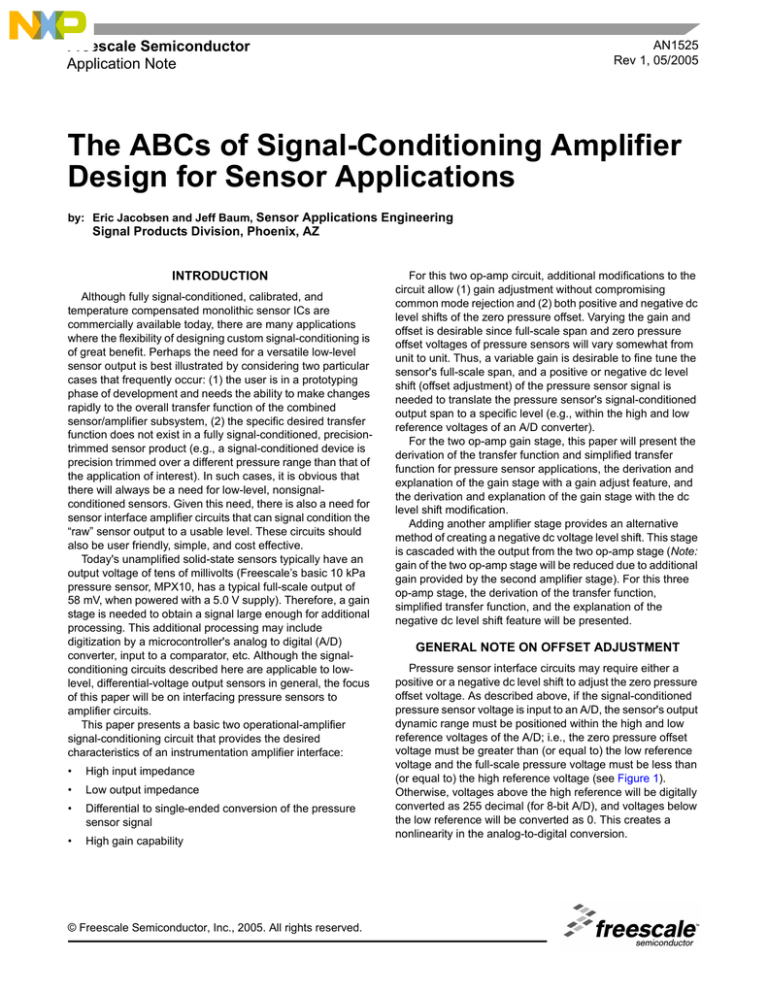
Freescale Semiconductor
Application Note
AN1525
Rev 1, 05/2005
The ABCs of Signal-Conditioning Amplifier
Design for Sensor Applications
by: Eric Jacobsen and Jeff Baum, Sensor Applications Engineering
Signal Products Division, Phoenix, AZ
INTRODUCTION
Although fully signal-conditioned, calibrated, and
temperature compensated monolithic sensor ICs are
commercially available today, there are many applications
where the flexibility of designing custom signal-conditioning is
of great benefit. Perhaps the need for a versatile low-level
sensor output is best illustrated by considering two particular
cases that frequently occur: (1) the user is in a prototyping
phase of development and needs the ability to make changes
rapidly to the overall transfer function of the combined
sensor/amplifier subsystem, (2) the specific desired transfer
function does not exist in a fully signal-conditioned, precisiontrimmed sensor product (e.g., a signal-conditioned device is
precision trimmed over a different pressure range than that of
the application of interest). In such cases, it is obvious that
there will always be a need for low-level, nonsignalconditioned sensors. Given this need, there is also a need for
sensor interface amplifier circuits that can signal condition the
“raw” sensor output to a usable level. These circuits should
also be user friendly, simple, and cost effective.
Today's unamplified solid-state sensors typically have an
output voltage of tens of millivolts (Freescale’s basic 10 kPa
pressure sensor, MPX10, has a typical full-scale output of
58 mV, when powered with a 5.0 V supply). Therefore, a gain
stage is needed to obtain a signal large enough for additional
processing. This additional processing may include
digitization by a microcontroller's analog to digital (A/D)
converter, input to a comparator, etc. Although the signalconditioning circuits described here are applicable to lowlevel, differential-voltage output sensors in general, the focus
of this paper will be on interfacing pressure sensors to
amplifier circuits.
This paper presents a basic two operational-amplifier
signal-conditioning circuit that provides the desired
characteristics of an instrumentation amplifier interface:
•
High input impedance
•
Low output impedance
•
Differential to single-ended conversion of the pressure
sensor signal
•
High gain capability
© Freescale Semiconductor, Inc., 2005. All rights reserved.
For this two op-amp circuit, additional modifications to the
circuit allow (1) gain adjustment without compromising
common mode rejection and (2) both positive and negative dc
level shifts of the zero pressure offset. Varying the gain and
offset is desirable since full-scale span and zero pressure
offset voltages of pressure sensors will vary somewhat from
unit to unit. Thus, a variable gain is desirable to fine tune the
sensor's full-scale span, and a positive or negative dc level
shift (offset adjustment) of the pressure sensor signal is
needed to translate the pressure sensor's signal-conditioned
output span to a specific level (e.g., within the high and low
reference voltages of an A/D converter).
For the two op-amp gain stage, this paper will present the
derivation of the transfer function and simplified transfer
function for pressure sensor applications, the derivation and
explanation of the gain stage with a gain adjust feature, and
the derivation and explanation of the gain stage with the dc
level shift modification.
Adding another amplifier stage provides an alternative
method of creating a negative dc voltage level shift. This stage
is cascaded with the output from the two op-amp stage (Note:
gain of the two op-amp stage will be reduced due to additional
gain provided by the second amplifier stage). For this three
op-amp stage, the derivation of the transfer function,
simplified transfer function, and the explanation of the
negative dc level shift feature will be presented.
GENERAL NOTE ON OFFSET ADJUSTMENT
Pressure sensor interface circuits may require either a
positive or a negative dc level shift to adjust the zero pressure
offset voltage. As described above, if the signal-conditioned
pressure sensor voltage is input to an A/D, the sensor's output
dynamic range must be positioned within the high and low
reference voltages of the A/D; i.e., the zero pressure offset
voltage must be greater than (or equal to) the low reference
voltage and the full-scale pressure voltage must be less than
(or equal to) the high reference voltage (see Figure 1).
Otherwise, voltages above the high reference will be digitally
converted as 255 decimal (for 8-bit A/D), and voltages below
the low reference will be converted as 0. This creates a
nonlinearity in the analog-to-digital conversion.
.
Sensor’s Full-Scale
Voltage Spans
Full-Scale
Output Voltage
Zero Pressure
Offset Voltage
A/D’S or Amplifier’s Dynamic Range
A/D High Reference of High
Saturation Level of Amplifier
A/D Low Reference or Low
Saturation Level of Amplifier
Figure 1. Positioning the Sensor’s Full-Scale Span within the A/D’s or Amplifier’s Dynamic Range
THE TWO OP-AMP GAIN STAGE
TRANSFER FUNCTION
A similar requirement that warrants the use of a dc level
shift is the prevention of the pressure sensor's voltage from
extending into the saturation regions of the operational
amplifiers. This also would cause a nonlinearity in the sensor
output measurements. For example, if an op-amp powered
with a single-ended 5.0 V supply saturates near the low rail of
the supply at 0.2 V, a positive dc level shift may be required to
position the zero pressure offset voltage at or above 0.2 V.
Likewise, if the same op-amp saturates near the high rail of
the supply at 4.8 V, a negative dc level shift may be required
to position the full-scale pressure voltage at or below 4.8 V. It
should be obvious that if the gain of the amplifiers is too large,
the span may be too large to be positioned within the 4.6 V
window (regardless of ability to level shift dc offset). In such a
case, the gain must be decreased to reduce the span.
The transfer function of the two op-amp signal-conditioning
stage, shown in Figure 2, can be determined using nodal
analysis at nodes 1 and 2. The analysis can be simplified by
calculating the transfer function for each of the signals with the
other two signals grounded (set to zero), and then employing
superposition to realize the overall transfer function. As shown
in Figure 2, VIN2 and VIN1 are the differential amplifier input
signals (with VIN2 > VIN1), and VREF is the positive dc level
adjust point. For a sensor with a small zero pressure offset
and operational amplifiers powered from a single-ended
supply, it may be necessary to add a positive dc level shift to
keep the operational amplifiers from saturating near zero
volts.
VCC
Node 1
VREF
VIN1
VIN2
R2
Node 2
R1
R4
R3
U1
U1
VO
VO
Figure 2. The Two Operational-Amplifier Gain Stage
AN1525
2
Sensors
Freescale Semiconductor
APPLICATION TO PRESSURE
SENSOR CIRCUITS
First, the transfer function for VIN1 is determined by
grounding VREF and VIN2 at Node 1:
V IN1
V O′ – V IN1
-------------- = ------------------------------R2
R1
(1)
and at Node 2:
V O′
VO
---------- = – -------R3
R4
The previous section showed the derivation of the general
transfer function for the two op-amp signal-conditioning circuit.
The simplified form of this transfer function, as applied to a
pressure sensor application, is derived in this section.
For pressure sensors, VIN1 and VIN2 are referred to as Sand S+, respectively. The simplification is obtained by setting
R4
R1
------- = ------R3
R2
(2)
By solving Equations (1) and (2) for VO’ and equating the
results, Equation (3) is established:
R3
⎛ R2
⎞
⎜ ------- + 1⎟ V IN1 = – ------- V O
R
R4
⎝ 1
⎠
R4
G = ------- + 1
R3
(4)
To determine the transfer function for VIN2, VIN1, and VREF
are grounded, and a similar analysis is used, yielding:
(6)
where VOREF represents the part of VO that VREF contributes.
Using superposition for the contributions of VIN1, VIN2, and
VREF gives the overall transfer function for the signalconditioning stage.
V O = V O1 + V O2 + V OREF
R4 R2
⎛ R 4⎞ ⎛ R 2
⎞
⎛ R4
⎞
V O = ⎜ – -------⎟ ⎜ ------- + 1⎟ V IN1 + ⎜ ------- + 1⎟ V IN2 + ---------------- V REF (7)
R
R
R3 R1
R
⎝ 3⎠ ⎝ 1
⎠
⎝ 3
⎠
Equation (7) is the general transfer function for the signalconditioning stage. However, the general form is not only
cumbersome, but also if care is not taken to match certain
resistance ratios, poor common mode rejection results. A
simplified form of this equation that provides good common
mode rejection is shown in the next section.
(9)
Also, since the differential voltage between S+ and S– is the
pressure sensor’s actual differential output voltage
(VSENSOR), the following equation is obtained for VO:
⎛ R4
⎞
V O = ⎜ ------- + 1⎟ V SENSOR + V REF
R
⎝ 3
⎠
(5)
where VO2 represents the part of VO that VIN2 contributes.
Finally, to calculate the transfer function between VO and
VREF, VIN1, and VIN2 are grounded to obtain the following
transfer function:
R4 R2
V OREF = ---------------- V REF
R3 R1
(8)
By examining Equation (8), the differential gain of the
signal-conditioning stage is:
where VO1 represents the part of VO that VIN1 contributes.
⎛ R4
⎞
V O2 = ⎜ ------- + 1⎟ V IN2
⎝ R3
⎠
⎛ R4
⎞
+ V O = ⎜ ------- + 1⎟ ( S – S ) + VREF
⎝ R3
⎠
(3)
Solving for VO yields:
R4 ⎛ R2
⎞
V O1 = – ------- ⎜ ------- + 1⎟ V IN1
R3 ⎝ R1
⎠
Through this simplification, Equation (7) reduces to
(10)
Finally, the term VREF is the positive offset voltage added to
the amplified sensor output voltage. VREF can only be positive
when using a positive single-ended supply. This offset (dc
level shift) allows the user to adjust the absolute range that the
sensor voltage spans. For example, if the gain established by
R4 and R3 creates a span of four volts and this signal swing is
superimposed upon a dc level shift (offset) of 0.5 volts, then a
signal range from 0.5 V to 4.5 V results.
VREF is typically adjusted by a resistor divider as shown
in Figure 3. A few design constraints are required when
designing the resistor divider to set the voltage at VREF.
•
To establish a stable positive dc level shift (VREF), VCC
should be regulated; otherwise, VREF will vary as VCC
varies.
•
When looking into the resistor divider from R1, the effective
resistance of the parallel combination of the resistors,
RREF1 and RREF2, should be at least an order of
magnitude smaller than R1's resistance. If the resistance of
the parallel combination is not small in comparison to R1,
R1's value will be significantly affected by the parallel
combination's resistance. This effect on R1 will
consequently affect the amplifier's gain and reduce the
common mode rejection.
AN1525
Sensors
Freescale Semiconductor
3
without additional constraints on the resistor values. To obtain
good common mode rejection, use a similar simplification as
before; that is, set
VCC
R1 = R4
R1
VREF
To U1
Defining the voltage differential between VIN2 and VIN1 as
VSENSOR, the simplified transfer function is
RREF2
⎛ R 4 2R 4
⎞
V O = ⎜ ------- + ----------- + 1⎟ V SENSOR + V REF
R
R
⎝ 3
⎠
G
R 4 2R 4
G = ------- + ----------- + 1
R3 RG
THE TWO OP-AMP GAIN STAGE WITH
VARIABLE GAIN
Varying the gain of the two op-amp stage is desirable for
fine-tuning the sensor's signal-conditioned output span.
However, to adjust the gain in the two op-amp gain circuit in
Figure 2 and to simultaneously preserve the common mode
rejection, two resistors must be adjusted. To adjust the gain, it
is more desirable to change one resistor. By adding an
additional feedback resistor, RG, the gain can be adjusted with
this one resistor while preserving the common mode rejection.
Figure 4 shows the two op-amp gain stage with the added
resistor, RG.
RG
VREF
VIN1
VIN2
VCC
R2
VO
U1
VO
U1
Figure 4. Two Operational-Amplifier Gain Stage with
Variable Gain
As with the two op-amp gain stage, nodal analysis and
superposition are used to derive the general transfer function
for the variable gain stage.
⎛ R4 R4 R2 R4
⎞
V O = ⎜ ------- + --------- + ----------------- + 1⎟ V IN2
⎝ R3 RG R3 RG
⎠
⎛ R 4 R 4 R 2 R 4 R 2 R 4⎞
– ⎜ ------- + --------- + ----------------- + ----------------⎟ V IN1
⎝ R 3 R G R 3 R G R 1 R 3⎠
⎛ R 2 R 4⎞
+ ⎜ ----------------⎟ V REF
⎝ R 1 R 3⎠
(11)
This general transfer function also is quite cumbersome
and is susceptible to producing poor common mode rejection
(13)
and VREF is the positive dc level shift (offset).
Use the following guidelines when determining the value for
RG:
• By examining the gain equation, RG's resistance should be
comparable to R4's resistance. This will allow fine tuning of
the gain established by R4 and R3. If RG is too large (e.g., RG
approaches ∞), it will have a negligible effect on the gain. If
RG is too small (e.g., RG approaches zero), the RG term will
dominate the gain expression, thus prohibiting fine
adjustment of the gain established via the ratio of R4 and R3.
•
Use a potentiometer for RG that has a resistance range on
the order of R4 (perhaps with a maximum resistance equal
to the value of R4). If a fixed resistor is preferable to a
potentiometer, use the potentiometer to adjust the gain,
measure the potentiometer's resistance, and replace the
potentiometer with the closest one percent resistor value.
•
To maintain good common mode rejection while varying
the gain, RG should be the only resistor that is varied. RG
equally modifies both of the resistor ratios which need to
be well-matched for good common mode rejection, thus
preserving the common mode rejection.
R4
Node 2
R3
R1
(12)
Thus, the gain is
Figure 3. A Resistor Divider to Create VREF
Node 1
R1 = R4
and
RREF1
THE TWO OP-AMP GAIN STAGE WITH VARIABLE
GAIN AND NEGATIVE DC LEVEL SHIFT
The last two op-amp circuits both incorporate positive dc
level shift capability. Recall that a positive dc level shift is
required to keep the operational amplifiers from saturating
near the low rail of the supply or to keep the zero pressure
offset above (or equal to) the low reference voltage of an A/D.
This two op-amp stage incorporates an additional resistor,
ROFF, to provide a negative dc level shift. A negative dc level
shift is useful when the zero pressure offset voltage of the
sensor is too high. In this case, the user may be required to
level shift the zero pressure offset voltage down (toward zero
volts). Now, for a specified amount of gain, the full-scale
pressure output voltage does not saturate the amplifier at the
high rail of the voltage supply, nor is it greater than the A/D's
high reference voltage. Figure 5 shows the schematic for this
amplifier circuit.
AN1525
4
Sensors
Freescale Semiconductor
VCC
ROFF
RG
Node1
VREF
R2
R1
Node 2
U1
R3
VIN1
R4
U1
VO
VO
VIN2
Figure 5. Two Op-Amp Signal Conditioning Stage with Variable Gain and Negative dc Level Shift Adjust
To derive the general transfer function, nodal analysis and
superposition are used:
⎛ R4 R4 R2 R4
⎞
V O = ⎜ ------- + --------- + ----------------- + 1⎟ V IN2
R
R
R
R
⎝ 3
⎠
G
3 G
⎛ R4 R4 R2 R4 R2 R4 ⎞
– ⎜ ------- + --------- + ---------------- + -----------------⎟ V IN1
⎝ R 3 R G R 1 R 3 R 3 R G⎠
R2 R4
R4
+ ---------------- V REF + ----------------- ( V IN2 – V CC ) (14)
R1 R3
R OFF
As before, defining the sensor's differential output as
VSENSOR, defining VIN2 as S+ for pressure sensor
applications, and using the simplification that
R1 = R4
and
R2 = R3
obtains the following simplified transfer function:
⎛ R 4 2R 4
⎞
V O = ⎜ ------- + ----------- + 1⎟ V SENSOR + V REF
⎝ R3 RG
⎠
R4
+
+ ----------------- ( S – V CC )
R OFF
(15)
The gain is
R 4 2R 4
G = ------- + ----------- + 1
R3 RG
(16)
To adjust the gain, refer to the guidelines presented in the
section on Two Op-Amp Gain Stage with Variable Gain.
VREF is the positive dc level shift, and the negative dc level
shift is:
R4
(17)
V – shift = ----------------- ( S+– V CC )
R OFF
The following guidelines will help design the circuitry for the
negative dc voltage level shift:
•
To establish a stable negative dc level shift, VCC should be
regulated; otherwise, the amount of negative level shift will
vary as VCC varies.
•
ROFF should be the only resistor varied to adjust the
negative level shift. Varying R4 will change the gain of the
two op-amp circuit and reduce the common mode
rejection.
•
To determine the value of ROFF:
1. Determine the amount of negative dc level shifting
required (defined here as V–SHIFT).
2. R4 already should have been determined to set the gain
for the desired signal-conditioned sensor output.
3. Although V–SHIFT is dependent on S+, S+ changes only
slightly over the entire pressure range. With Freescale’s
MPX10 powered at a 5.0 V supply, S+ will have a value
of approximately 2.51 V at zero pressure and will
increase as high as 2.53 V at full-scale pressure. This
error over the full-scale pressure span of the device is
negligible when considering that many applications use
an 8-bit A/D converter to segment the pressure range.
Using an 8-bit A/D, the 20 mV (0.02 V) error
corresponds to only 1 bit of error over the entire
pressure range (1 bit / 255 bits x 100% = 0.4% error).
4. ROFF is then calculated by the following equation:
S +– V CC
R OFF = ----------------------- R 4
V – shift
(18)
An alternative to using this equation is to use a
potentiometer for ROFF that has a resistance range on the
order of R4 (perhaps 1 to 5 times the value of R4). Use the
potentiometer to fine tune the negative dc level shift, while
monitoring the zero pressure offset output voltage, VO. As
before, if a fixed resistor is preferable, then measure the
potentiometer's resistance and replace the potentiometer with
the closest 1% resistor value.
Important Note: The common mode rejection of this
amplifier topology will be low and perhaps unacceptable in
some applications. (A SPICE model of this amplifier topology
showed the common mode rejection to be 28 dB.) However,
AN1525
Sensors
Freescale Semiconductor
5
this circuit is presented as a solution for applications where
only two operational amplifiers are available and the common
mode rejection is not critical when considering the required
system performance. Adding a third op-amp to the circuit for
the negative dc level shifting capability (as shown in the next
section) is a solution that provides good common mode
rejection, but at the expense of adding an additional op-amp.
•
Its non-inverting configuration provides gain via the ratio of
R6 and R5.
•
It has negative dc voltage level shifting capability typically
created by a resistor divider at V-SHIFT, as discussed in the
section on Application to Pressure Sensor Circuits.
Although this configuration requires a third op-amp for the
negative dc level shift, it has no intrinsic error nor low
common mode rejection associated with the negative level
shift (as does the previous two op-amp stage). Depending
on the application's accuracy requirement, this may be a
more desirable configuration for providing the negative dc
level shift.
THE THREE OP-AMP GAIN STAGE
FOR NEGATIVE dc LEVEL SHIFTING
This circuit adds a third op-amp to the output of the two opamp gain block (see Figure 6). This op-amp has a dual
function in the overall amplifier circuit:
VCC
RG
R5
V–SHIFT
R2
R6
R4
R1
R3
VREF
VIN1
U1
U1
VO
VIN2
U1
VO
VO
Figure 6. Three Op-Amp Gain Stage with Variable Gain and Negative DC Level Shift
[(
R4 R4 R2 R4
------- + --------- + ----------------- + 1 V IN2
R3 RG R3 RG
(
[
[
R6
V O = 1 + ------R5
(19)
[
First, use the same simplifications as before; that is, set
R1 = R4
and
R2 = R3
[
R6
V O = 1 + ------R5
[
⎛ R 4 2R 4
⎞
⎜ ------- + ----------- + 1⎟ ( V SENSOR )
⎝ R3 RG
⎠
R6
+ V REF – -------V – shift
R5
(20)
The gain is
R6
G = 1 + ------R5
⎛ R 4 R 4 R 2 R 4 R 2 R 4⎞
– ⎜ ------- + --------- + ----------------- + ----------------⎟ V IN1
⎝ R 3 R G R 3 R G R 1 R 3⎠
R6
⎛ R 2 R 4⎞
-⎟ V
– -------V – shift
+ ⎜ --------------REF
R5
⎝ R 1 R 3⎠
Defining the voltage differential between VIN2 and VIN1 as
VSENSOR, the simplified transfer function is
[
[
The transfer function for this stage will be similar to the
chosen two op-amp gain stage configuration (either the fixed
gain with positive dc level shift circuit or the variable gain with
positive dc level shift circuit) with additional terms for the
negative level shift and gain. As an example, the variable-gain
two op-amp gain circuit is used here. All of the design
considerations and explanations for the variable gain two opamp circuit apply.
The transfer function may be derived with nodal analysis
and superposition.
R 4 2R 4
------- + ----------- + 1
R3 RG
(21)
VREF is the positive dc level shift (offset), and V–SHIFT is the
negative dc level shift.
The preceding simplifications have been performed in the
previous sections, but by examining Equation 20, notice that
the third op-amp's gain term also amplifies the positive and
negative dc voltage level shifts, VREF and V–SHIFT. If R6 and R5
are chosen to make an arbitrary contribution to the overall
system gain, designing an appropriate amount of positive and
negative dc level shift can be difficult. To simplify the transfer
function, set R5 = R6, and the following equation for VO results:
⎛ R 4 2R 4
⎞
V O = 2 ⎜ ------- + ----------- + 1⎟ ( V SENSOR ) + V REF – V – shift
⎝ R3 RG
⎠
(22)
AN1525
6
Sensors
Freescale Semiconductor
Now the third op-amp's contribution to the overall system
gain is a factor of two. When designing the overall system gain
and the positive dc level shift, use the following guidelines:
• Since the third op-amp contributes a gain of two to the
overall system, design the gain that the two op-amp circuit
contributes to the system to be one-half the desired
system gain. The gain term for the two op-amp circuit is:
R 4 2R 4
G = ------- + ----------- + 1
R3 RG
which is the same as presented in Equation 16.
•
Similarly, since the third op-amp also amplifies VREF by
two (refer to Equation 22), the resistor divider that creates
VREF should be designed to provide one-half the desired
positive dc voltage level shift needed for the final output.
When designing the voltage divider for VREF, use the same
design constraints as were given in the section on
Application to Pressure Sensor Circuits.
With the above simplification of R5 = R6, the negative dc
level shift, V–SHIFT, which is also created by a voltage divider,
is now amplified by a factor of unity. When designing the
voltage divider, use the same design constraints as were
presented in the section on Application to Pressure Sensor
Circuits.
CONCLUSION
The amplifier circuits discussed in this paper apply to
pressure sensor applications, but the amplifier circuits can be
interfaced to low-level, differential-voltage output sensors, in
general. All of the circuits exhibit the desired instrumentation
amplifier characteristics of high input impedance, low output
impedance, high gain capability, and differential to singleended conversion of the sensor signal. Each amplifier circuit
provides positive dc level shift capability, while the last two
circuit topologies presented are also able to provide a
negative dc voltage level shift. This enables the user to
position the sensor's dynamic output within a specified range
(e.g., within the high and low references of an A/D converter).
Also detailed is a method of using an additional feedback
resistor to adjust easily the differential voltage gain, while not
sacrificing common mode rejection. Combining the
appropriate sensor device and amplifier interface circuit
provides sensor users with a versatile system solution for
applications in which the ideal fully single-conditioned sensor
does not exist or in which such signal flexibility is warranted.
AN1525
Sensors
Freescale Semiconductor
7
How to Reach Us:
Home Page:
www.freescale.com
E-mail:
support@freescale.com
USA/Europe or Locations Not Listed:
Freescale Semiconductor
Technical Information Center, CH370
1300 N. Alma School Road
Chandler, Arizona 85224
+1-800-521-6274 or +1-480-768-2130
support@freescale.com
Europe, Middle East, and Africa:
Freescale Halbleiter Deutschland GmbH
Technical Information Center
Schatzbogen 7
81829 Muenchen, Germany
+44 1296 380 456 (English)
+46 8 52200080 (English)
+49 89 92103 559 (German)
+33 1 69 35 48 48 (French)
support@freescale.com
Japan:
Freescale Semiconductor Japan Ltd.
Headquarters
ARCO Tower 15F
1-8-1, Shimo-Meguro, Meguro-ku,
Tokyo 153-0064
Japan
0120 191014 or +81 3 5437 9125
support.japan@freescale.com
Asia/Pacific:
Freescale Semiconductor Hong Kong Ltd.
Technical Information Center
2 Dai King Street
Tai Po Industrial Estate
Tai Po, N.T., Hong Kong
+800 2666 8080
support.asia@freescale.com
For Literature Requests Only:
Freescale Semiconductor Literature Distribution Center
P.O. Box 5405
Denver, Colorado 80217
1-800-441-2447 or 303-675-2140
Fax: 303-675-2150
LDCForFreescaleSemiconductor@hibbertgroup.com
AN1525
Rev. 1
05/2005
Information in this document is provided solely to enable system and software
implementers to use Freescale Semiconductor products. There are no express or
implied copyright licenses granted hereunder to design or fabricate any integrated
circuits or integrated circuits based on the information in this document.
Freescale Semiconductor reserves the right to make changes without further notice to
any products herein. Freescale Semiconductor makes no warranty, representation or
guarantee regarding the suitability of its products for any particular purpose, nor does
Freescale Semiconductor assume any liability arising out of the application or use of any
product or circuit, and specifically disclaims any and all liability, including without
limitation consequential or incidental damages. “Typical” parameters that may be
provided in Freescale Semiconductor data sheets and/or specifications can and do vary
in different applications and actual performance may vary over time. All operating
parameters, including “Typicals”, must be validated for each customer application by
customer’s technical experts. Freescale Semiconductor does not convey any license
under its patent rights nor the rights of others. Freescale Semiconductor products are
not designed, intended, or authorized for use as components in systems intended for
surgical implant into the body, or other applications intended to support or sustain life,
or for any other application in which the failure of the Freescale Semiconductor product
could create a situation where personal injury or death may occur. Should Buyer
purchase or use Freescale Semiconductor products for any such unintended or
unauthorized application, Buyer shall indemnify and hold Freescale Semiconductor and
its officers, employees, subsidiaries, affiliates, and distributors harmless against all
claims, costs, damages, and expenses, and reasonable attorney fees arising out of,
directly or indirectly, any claim of personal injury or death associated with such
unintended or unauthorized use, even if such claim alleges that Freescale
Semiconductor was negligent regarding the design or manufacture of the part.
Freescale™ and the Freescale logo are trademarks of Freescale Semiconductor, Inc.
All other product or service names are the property of their respective owners.
© Freescale Semiconductor, Inc. 2005. All rights reserved.

